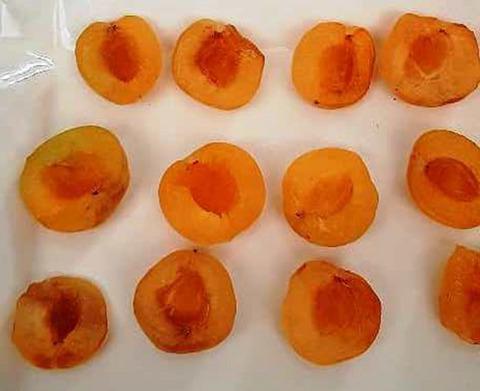当前位置:
X-MOL 学术
›
Food Sci. Nutr.
›
论文详情
Our official English website, www.x-mol.net, welcomes your feedback! (Note: you will need to create a separate account there.)
Identification of superior late-blooming apricot (Prunus armeniaca L.) genotypes among seedling-originated trees
Food Science & Nutrition ( IF 3.5 ) Pub Date : 2022-01-18 , DOI: 10.1002/fsn3.2747 Zeinab Mashhadi 1 , Ali Khadivi 1
Food Science & Nutrition ( IF 3.5 ) Pub Date : 2022-01-18 , DOI: 10.1002/fsn3.2747 Zeinab Mashhadi 1 , Ali Khadivi 1
Affiliation

|
One of the major limiting factors in the intensive spread of apricot (Prunus armeniaca L.) in most of the countries is spring frost. Thus, the breeding efforts have concentrated on the use of late-blooming genotypes as a means of frost avoidance. The aim of the present study was to identify late-blooming genotypes with high fruit quality among seedling-originated trees. Firstly, pre-selections were done according to blooming time within 278 apricot seedling-originated trees. Secondly, the late-blooming selections were further evaluated according to their vegetative and fruit characteristics to determine superior types. Significant differences were observed among the late-blooming genotypes in terms of the traits recorded. Fruit ground color was strongly variable, including white, yellow, yellow–green, light orange, orange, and dark orange. Fruit weight ranged from 27.37 to 33.99 g, fruit flesh thickness varied from 11.16 to 13.47 mm, and total soluble solids varied between 17.00% and 23.87%. Hierarchical cluster analysis (HCA) performed with Euclidean distance and Ward's method divided the genotypes into two main clusters based on morphological traits and in some cases, the genotypes belonging to an area were clustered into different clusters. All the 48 late-blooming date genotypes selected could be useful as a parent to improve flowering season of cultivars. Also, among them, 10 genotypes were superior in terms of fruit quality-related characters, such as fruit weight, fruit color, fruit taste, and TSS, and thus they can be singled out for cultivation.
中文翻译:

晚熟杏(Prunus armeniaca L.)基因型的鉴定
杏( Prunus armeniaca)密集传播的主要限制因素之一L.) 在大多数国家是春季霜冻。因此,育种工作集中在使用晚开花基因型作为避免霜冻的手段。本研究的目的是在苗木起源的树木中鉴定具有高果实品质的晚开花基因型。首先,在278株杏树苗木中根据开花时间进行预选。其次,根据其营养和果实特性进一步评估晚开花选择,以确定优良类型。在记录的性状方面,晚开花基因型之间存在显着差异。果实底色变化很大,包括白色、黄色、黄绿色、浅橙色、橙色和深橙色。单果重27.37~33.99克,果肉厚11.16~13。47 毫米,总可溶性固体在 17.00% 和 23.87% 之间变化。使用欧几里得距离和 Ward 方法进行的层次聚类分析 (HCA) 根据形态特征将基因型分为两个主要聚类,在某些情况下,属于一个区域的基因型被聚类为不同的聚类。选择的所有 48 个晚开花日期基因型都可以作为亲本来改善栽培品种的开花季节。另外,其中有10个基因型在果重、果色、果味、TSS等果实品质相关性状上均较优,可单独选育。s方法根据形态特征将基因型分为两个主要簇,在某些情况下,属于一个区域的基因型会聚集到不同的簇中。选择的所有 48 个晚开花日期基因型都可以作为亲本来改善栽培品种的开花季节。另外,其中有10个基因型在果重、果色、果味、TSS等果实品质相关性状上均较优,可单独选育。s方法根据形态特征将基因型分为两个主要簇,在某些情况下,属于一个区域的基因型会聚集到不同的簇中。选择的所有 48 个晚开花日期基因型都可以作为亲本来改善栽培品种的开花季节。另外,其中有10个基因型在果重、果色、果味、TSS等果实品质相关性状上均较优,可单独选育。
更新日期:2022-01-18
中文翻译:

晚熟杏(Prunus armeniaca L.)基因型的鉴定
杏( Prunus armeniaca)密集传播的主要限制因素之一L.) 在大多数国家是春季霜冻。因此,育种工作集中在使用晚开花基因型作为避免霜冻的手段。本研究的目的是在苗木起源的树木中鉴定具有高果实品质的晚开花基因型。首先,在278株杏树苗木中根据开花时间进行预选。其次,根据其营养和果实特性进一步评估晚开花选择,以确定优良类型。在记录的性状方面,晚开花基因型之间存在显着差异。果实底色变化很大,包括白色、黄色、黄绿色、浅橙色、橙色和深橙色。单果重27.37~33.99克,果肉厚11.16~13。47 毫米,总可溶性固体在 17.00% 和 23.87% 之间变化。使用欧几里得距离和 Ward 方法进行的层次聚类分析 (HCA) 根据形态特征将基因型分为两个主要聚类,在某些情况下,属于一个区域的基因型被聚类为不同的聚类。选择的所有 48 个晚开花日期基因型都可以作为亲本来改善栽培品种的开花季节。另外,其中有10个基因型在果重、果色、果味、TSS等果实品质相关性状上均较优,可单独选育。s方法根据形态特征将基因型分为两个主要簇,在某些情况下,属于一个区域的基因型会聚集到不同的簇中。选择的所有 48 个晚开花日期基因型都可以作为亲本来改善栽培品种的开花季节。另外,其中有10个基因型在果重、果色、果味、TSS等果实品质相关性状上均较优,可单独选育。s方法根据形态特征将基因型分为两个主要簇,在某些情况下,属于一个区域的基因型会聚集到不同的簇中。选择的所有 48 个晚开花日期基因型都可以作为亲本来改善栽培品种的开花季节。另外,其中有10个基因型在果重、果色、果味、TSS等果实品质相关性状上均较优,可单独选育。




































 京公网安备 11010802027423号
京公网安备 11010802027423号